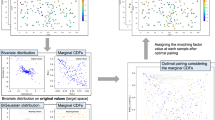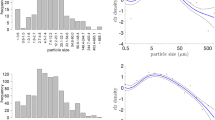Abstract
Modeling a mineral microstructure accurately in three dimensions can render realistic mineralogical patterns which can be used for three-dimensional processing simulations and calculation of three-dimensional mineral quantities. The present study introduces a flexible approach to model the microstructure of mineral material composed of a large number of facies. The common plurigaussian method, a valuable approach in geostatistics, can account for correlations within each facies and in principle be extended to correlations between the facies. Assuming stationarity and isotropy, founded on a new description of this model, formulas for first- and second-order characteristics, such as volume fraction, correlation function and cross-correlation function can be given by a multivariate normal distribution. In this particular situation, based on first- and second-order statistics, a fitting procedure can be developed which requires only numerical inversion of several one-dimensional monotone functions. The paper describes the whole workflow. The covariance structure is quickly obtained from two-dimensional particle pixel images using Fourier transform. Followed by model fitting and sampling, where the resulting three-dimensional microstructure is then efficiently represented by tessellations. The applicability is demonstrated for the three-dimensional case by modeling the microstructure from a Mineral Liberation Analyzer image data set of an andesitic basalt breccia.










Similar content being viewed by others
References
Adler RJ (2010) The geometry of random fields, vol 62. SIAM, Philadelphia
Altendorf H, Latourte F, Jeulin D, Faessel M, Saintoyant L (2014) 3d reconstruction of a multiscale microstructure by anisotropic tessellation models. Image Analysis & Stereology 33(2):121–130
Apanasovich TV, Genton MG (2010) Cross-covariance functions for multivariate random fields based on latent dimensions. Biometrika 97(1):15–30
Armstrong M, Galli A, Beucher H, Loc’h G, Renard D, Doligez B, Eschard R, Geffroy F (2011) Plurigaussian simulations in geosciences. Springer, Berlin
Azaïs JM, Wschebor M (2009) Level sets and extrema of random processes and fields. Wiley, Hoboken
Bilodeau M, Meyer F, Schmitt M (2005) Space, structure and randomness. Springer, Berlin
Boyd S, Vandenberghe L (2004) Convex optimization. Cambridge University Press, Cambridge
Chiu SN, Stoyan D, Kendall WS, Mecke J (2013) Stochastic geometry and its applications. Wiley, Hoboken
Deutsch C, Tran T (2002) FLUVSIM: a program for object-based stochastic modeling of fluvial depositional systems. Comput Geosci 28(4):525–535
Doligez B, Hamon Y, Barbier M, Nader F, Lerat O, Beucher H (2011) Advanced workflows for joint modeling of sedimentary facies and diagenetic overprint. In: Impact on reservoir quality. SPE Paper# SPE-146621, SPE annual technical conference and exhibition, Denver, Colorado, USA
Emery X (2007) Simulation of geological domains using the plurigaussian model: new developments and computer programs. Comput Geosci 33(9):1189–1201
Emery X, Arroyo D, Porcu E (2016) An improved spectral turning-bands algorithm for simulating stationary vector gaussian random fields. Stoch Environ Res Risk Assess 30:1863–1873
Fandrich R, Gu Y, Burrows D, Moeller K (2007) Modern SEM-based mineral liberation analysis. Int J Miner Process 84(1):310–320
Gallier J (2010) The schur complement and symmetric positive semidefinite (and definite) matrices. Penn Engineering, Danboro
Gelfand AE, Banerjee S (2010) Multivariate spatial process models. Handbook of Spatial Statistics, pp 495–515
Genton MG, Kleiber W (2015) Cross-covariance functions for multivariate geostatistics. Stat Sci 30(2):147–163
Genz A (1992) Numerical computation of multivariate normal probabilities. J Comput Graph Stat 1(2):141–149
Genz A, Bretz F (2002) Comparison of methods for the computation of multivariate t probabilities. J Comput Graph Stat 11(4):950–971
Genz A, Bretz F (2009) Computation of multivariate normal and t probabilities. Lecture Notes in Statistics. Springer, Heidelberg: Springer-Verlag. ISBN: 978-3-642-01688-2
Genz A, Bretz F, Miwa T, Mi X, Leisch F, Scheipl F, Hothorn T (2016) mvtnorm: multivariate normal and t distributions. R package version 1.0-5
Gilbert GT (1991) Positive definite matrices and Sylvester’s criterion. Am Math Mon 98(1):44–46
Gneiting T, Kleiber W, Schlather M (2012) Matérn cross-covariance functions for multivariate random fields. J Am Stat Assoc 105:1167–1177
Gu Y (2003) Automated scanning electron microscope based mineral liberation analysis an introduction to JKMRC/FEI mineral liberation analyser. J Miner Mater Charact Eng 2(01):33
Hansen N, Müller SD, Koumoutsakos P (2003) Reducing the time complexity of the derandomized evolution strategy with covariance matrix adaptation (CMA-ES). Evol Comput 11(1):1–18
Hug D, Last G, Weil W (2002) A survey on contact distributions. In: Morphology of condensed matter. Springer, pp 317–357
Ip RH, Li W (2016) Matérn cross-covariance functions for bivariate spatio-temporal random fields. Spatial Stat 17:22–37
Jussel P, Stauffer F, Dracos T (1994) Transport modeling in heterogeneous aquifers: 1. statistical description and numerical generation of gravel deposits. Water Resour Res 30(6):1803–1817
Kim S, Casper R (2013) Applications of convolution in image processing with Matlab. University of Washington, Seattle
Koltermann CE, Gorelick SM (1996) Heterogeneity in sedimentary deposits: a review of structure-imitating, process-imitating, and descriptive approaches. Water Resour Res 32(9):2617–2658
Le Loc’h G, Beucher H, Galli A, Doligez B (1994) Improvement in the truncated Gaussian method: combining several Gaussian functions. In: 4th European conference on the mathematics of oil recovery
Leißner T, Mütze T, Bachmann K, Rode S, Gutzmer J, Peuker U (2013) Evaluation of mineral processing by assessment of liberation and upgrading. Miner Eng 53:171–173
Li L, Shen L, Proust G (2015) Generalised voronoi tessellation for generating microstructural finite element models with controllable grain-size distributions and grain aspect ratios. Int J Numer Methods Eng 103(2):144–156
Mallet JL (2002) Geomodelling. Oxford University Press, Oxford
Mandelbrot BB (1983) The fractal geometry of nature, vol 173. WH freeman, New York
Matheron F (1975) Random sets and integral geometry (probability & mathematical statistics). Wiley, Hoboken
Mayer J (2011) A time-optimal algorithm for the estimation of contact distribution functions of random sets. Image Anal Stereol 23(3):177–183
Méndez-Venegas J, Díaz-Viera MA (2013) Geostatistical modeling of clay spatial distribution in siliciclastic rock samples using the plurigaussian simulation method. Geofísica internacional 52(3):229–247
Menzel P, Teichmann J, van den Boogaart K (2019) Efficient representation of Laguerre mosaics with an application to microstructure simulation of complex ore. Math Geosci. https://doi.org/10.1007/s11004-019-09841-5
Mi X, Miwa T, Hothorn T (2009) mvtnorm: New numerical algorithm for multivariate normal probabilities. R J 1(1):37–39
Molchanov I (2006) Theory of random sets. Springer, Berlin
Pérez-Barnuevo L, Pirard E, Castroviejo R (2012) Textural descriptors for multiphasic ore particles. Image Anal Stereol 31(3):175–184
Perez-Barnuevo L, Pirard E, Castroviejo R (2013) Automated characterisation of intergrowth textures in mineral particles: a case study. Miner Eng 52:136–142
Scheibe TD, Freyberg DL (1995) Use of sedimentological information for geometric simulation of natural porous media structure. Water Resour Res 31(12):3259–3270
Simonoff JS (2012) Smoothing methods in statistics. Springer, Berlin
Sobczyk K, Kirkner DJ (2012) Stochastic modeling of microstructures. Springer, Berlin
Spodarev E (2013) Stochastic geometry, spatial statistics and random fields: asymptotic methods, vol 2068. Springer, Berlin
Teichmann J, van den Boogaart KG (2016) Efficient simulation of stationary multivariate Gaussian random fields with given cross-covariance. Appl Math 7(17):2183
Trinh GB (2013) Computation of multivariate normal probabilities using bivariate conditioning with simulation. Ph.D. thesis, Washington State University
Ueda T, Oki T, Koyanaka S (2016) Novel numerical simulation of the stereological bias of binary particles. Mater Trans 57(3):438–444
Vassiliev P, Ledoux H, Gold C (2008) Modeling ore textures and mineral liberation using 3d voronoi diagrams. In: Proceedings of the international conference numerical geometry, grid generation and high performance computing, Moscow, Russia, pp 10–13
Zhang F (2006) The Schur complement and its applications, vol 4. Springer, Berlin
Acknowledgements
The presented study was part of the projects AMREP (Funding-nr: 033R119B) and REE NAM XE (Funding-nr: 033R120B) both funded by the BMBF (Federal Ministry of Education and Research, Germany) and the latter also by MOST (Ministry of Science and Technology) of Vietnam in terms of a collaboration with Hanoi University of Mining and Geology (HUMG) and Hung Hai Group (HHG). Both projects are part of the research program CLIENT ’International Partnerships for Sustainable Technologies and Services for Climate Protection and the Environment’.
Author information
Authors and Affiliations
Corresponding authors
Rights and permissions
About this article
Cite this article
Teichmann, J., Menzel, P., Heinig, T. et al. Modeling and Fitting of Three-Dimensional Mineral Microstructures by Multinary Random Fields. Math Geosci 53, 877–904 (2021). https://doi.org/10.1007/s11004-020-09871-4
Received:
Accepted:
Published:
Issue Date:
DOI: https://doi.org/10.1007/s11004-020-09871-4




